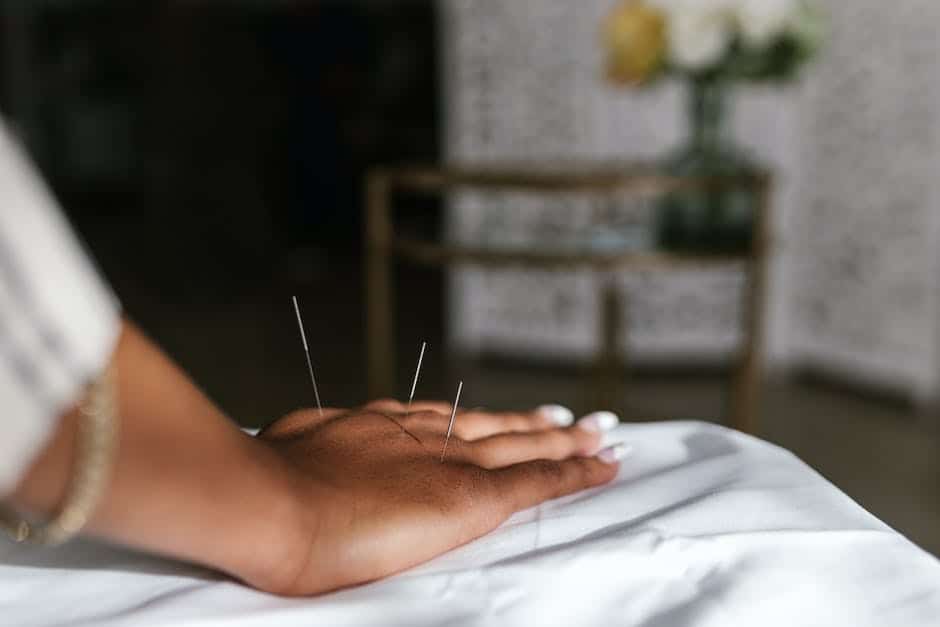How often do you find yourself wincing in discomfort owing to a relentless knot of pain? Acupuncture, a healing technique that has been around for millennia, might offer the relief you’ve been seeking. With its roots in Traditional Chinese Medicine (TCM), acupuncture has made a name for itself worldwide, including here at ActiveMed Integrative Health Center. Today, we’re focusing on the heart of this ancient practice—acupuncture needling.
Acupuncture needling involves the strategic insertion of thin, stainless-steel filiform needles at predefined points in the body. Far from being a distressing experience, these needles are much thinner than those used for injections or blood draws. The fear of pain often associated with needles is seldom warranted in acupuncture. As the needles nudge your body’s energy pathways, they seek to restore balance and prompt healing. They serve as tiny gatekeepers, nudging open the doors where energy has stagnated and pain has set up residence.
Here’s a quick overview of what acupuncture needling involves:
- Basis: Acupuncture is premised on Qi (pronounced chee) or energy flow.
- Procedure: Thin, stainless-steel, filiform needles are inserted along the body’s meridian lines to stimulate energy flow.
- Aim: The goal is to treat a variety of conditions, including, but not limited to, stomach pain, musculoskeletal pain, internal organ problems, mental health issues.
- Treatment Frequency: The number of treatments varies depending on the individual’s condition.

Understanding the Basics of Acupuncture Needling
To fully comprehend the benefits and techniques of acupuncture needling, understand its origins, philosophy, and how it contrasts with similar treatments, such as dry needling.
The Origin and Philosophy of Acupuncture
Acupuncture is an ancient therapeutic practice from China, with a history spanning over 2,000 years. It hinges on the principles of Traditional Chinese Medicine (TCM), which posits that the body’s health is governed by the flow of vital energy, or “Qi.” This Qi circulates within the body through channels called meridians, and any imbalance or blockage in this flow can lead to disease.
Acupuncture needling is a technique used to regulate the flow of Qi and restore balance. It involves the insertion of very thin, sterile needles into specific points on the body, known as acupuncture points or meridians.
The Role of Acupuncture Needling in Traditional Chinese Medicine
In Traditional Chinese Medicine, the role of acupuncture needling is to stimulate these acupuncture points, thereby influencing the flow of Qi. This stimulation can help restore the balance of Yin and Yang – the complementary forces that TCM focuses on for health balance.
Besides bringing energetic equilibrium, acupuncture needling is also guided by the Five Elements Theory, which helps understand body-environment relationships and assess imbalances in organs, meridians, seasons, and emotions. This comprehensive comprehension of the human body and its relationship to nature is what sets acupuncture apart from other forms of treatment.
The Difference Between Acupuncture and Dry Needling
While acupuncture and dry needling may appear similar due to their use of needles, they differ significantly in their approach and principles. Dry needling, a more modern technique rooted in Western medicine, focuses on treating physical dysfunction and pain.
In dry needling, needles are inserted into trigger points within muscles to relieve tension and decrease pain. This is different from acupuncture, where needles are inserted into specific points along meridians to restore the balance of energy flow.
The diagnosis for dry needling requires careful palpation of muscles by practitioners, whereas diagnosis for acupuncture involves determining imbalances in internal organ systems based on the patient’s symptoms and tongue/pulse pattern assessment results.
To summarize, while both methods use thin needles to alleviate pain, their underlying philosophies, techniques, and conditions treated vary significantly. At ActiveMed Integrative Health Center, we understand these differences and tailor our treatments to the specific needs and preferences of our patients. Whether you choose acupuncture or dry needling, our aim is to help you on your path to recovery and optimal health.
The Science Behind Acupuncture Needling
As we delve deeper into acupuncture, understand the science behind acupuncture needling. This will help alleviate any concerns and provide a clearer picture of what you can expect from this treatment.
How Acupuncture Needling Works
Acupuncture needling is based on the concept of Qi (pronounced “chi”), a vital energy force that flows through channels known as meridians in our body. Health is maintained when Qi is balanced, but imbalances can lead to illnesses and discomfort.
Acupuncture needling involves the insertion of thin, stainless-steel needles into specific points along these meridians. The goal is to stimulate and regulate the flow of Qi, thereby restoring energy balance and promoting health. The needles used are very thin, much thinner than those used for injections, which eases discomfort.
The Effectiveness of Acupuncture Needling: What Research Says
Modern research supports the effectiveness of acupuncture needling, particularly in providing relief from pain and muscle tension. A 2017 guideline from the American College of Physicians recommended acupuncture as a first-line treatment for chronic low-back pain.
Acupuncture needles, when inserted into specific points, can help relax muscles, reduce inflammation, and manage pain. This process is beneficial for conditions like arthritis, back pain, neck pain, and sciatica. It’s also used to treat mental health issues such as depression and anxiety.
Addressing Common Questions About Acupuncture Needling
What Does Acupuncture Needling Do?
Acupuncture needling stimulates the body’s healing process by restoring the balance of energy flow. It can alleviate various physical and mental conditions by targeting specific points that are connected to these issues. Whether it’s musculoskeletal pain, menstrual pain, sleep issues, or stress, acupuncture needling can help manage these conditions effectively.
Is Needle Acupuncture Good?
Yes, needle acupuncture is a well-established and effective treatment method. It’s used worldwide and has been incorporated into the formal training programs of many U.S. healthcare professionals. It’s also covered by some insurance companies, making it a more accessible treatment option for many individuals.
How Painful is Needling?
The fear of needles is common, but acupuncture needling is not typically a painful process. The needles used are very thin, and the insertion is often described as a slight pinch or a tingling sensation. Any discomfort is usually brief and worth it considering the potential benefits. At ActiveMed Integrative Health Center, we prioritize patient comfort and work with you to ensure a positive and beneficial acupuncture experience.
Understanding the science behind acupuncture needling can help alleviate worries and set realistic expectations. If you’re tired of relying on medication alone and seeking a more holistic approach to health, acupuncture could be the right choice for you. As always, consult with a trained healthcare professional before starting any new treatment.
5 Techniques to Master Acupuncture Needling
Acupuncture needling is a skill that requires expert knowledge and precision. At ActiveMed Integrative Health Center, we utilize the best practices to ensure our patients receive the most effective treatment. Here are five techniques we employ to master acupuncture needling and guarantee results:
Technique 1: Selecting the Right Acupuncture Points
Identifying the correct acupuncture points is paramount. Traditional Chinese Medicine (TCM) theory emphasizes that energy flow, or “qi”, needs to be balanced for health restoration. This balance is achieved by stimulating specific points on the body, known as acupoints. Each acupoint correlates to a particular organ system, and their correct identification ensures effective treatment .
Technique 2: Proper Needle Insertion
Acupuncture needles, made of thin and flexible stainless steel, are inserted into acupoints with minimal discomfort. These needles play a crucial role in stimulating the body’s energy flow and promoting blood circulation. The needles’ sterile and disposable nature ensures safety and hygiene during treatment .
Technique 3: Needle Manipulation for Optimal Results
Once the needles are inserted, they may be manipulated to achieve the desired therapeutic effect. This may involve gentle twisting or the application of electrical stimulation. We customize these needle stimulation techniques based on your individual condition and response to treatment .
Technique 4: Combining Acupuncture with Other Therapies
At ActiveMed, we believe in a comprehensive treatment approach. Hence, we often combine acupuncture with other therapies like massage techniques, orthopedic acupuncture, or auricular acupuncture. This integrative approach enhances the overall effectiveness of the treatment and provides more holistic care .
Technique 5: Ensuring Patient Comfort and Safety
While acupuncture needling is generally safe, there can be mild side effects such as bruising or an achy feeling where the needle is inserted. We prioritize patient comfort and safety, monitoring the treatment closely and making adjustments as needed. We also advise patients to avoid heavy meals and excessive caffeine before sessions, and encourage them to wear comfortable clothing and arrive well-rested .
Mastering these techniques allows us at ActiveMed to provide effective acupuncture needling treatments, promoting healing and well-being for our patients. Individual responses to acupuncture can vary, so a treatment plan that works well for one person may not be as effective for another. We always tailor our approach to meet each individual’s unique needs and health goals.
The Benefits and Risks of Acupuncture Needling
Acupuncture needling, an age-old practice rooted in Traditional Chinese Medicine, has a myriad of benefits. However, be aware of the potential risks and side effects as well. Let’s delve into the proven benefits and possible risks of acupuncture needling.
The Proven Benefits of Acupuncture Needling
Acupuncture is a versatile treatment, offering a holistic approach to treat a wide range of health conditions. It’s primarily used for pain management, but it can also address various other concerns.
- Pain Relief: Acupuncture has been proven to be effective in providing short-term relief from low back pain, knee pain caused by osteoarthritis, neck pain, and migraines. It’s also useful for managing menstrual and labor pains.
- Mental Health Improvement: Acupuncture can help treat mental health issues such as depression and anxiety, enhancing overall emotional well-being.
- Treatment of Other Conditions: Apart from pain and mental health, acupuncture can also treat respiratory disorders, sleep issues, and stress.
Potential Risks and Side Effects of Acupuncture Needling
While acupuncture needling provides numerous benefits, it’s crucial to consider the potential risks and side effects.
- Infection: The use of non-sterile needles can lead to infection or disease. At ActiveMed Integrative Health Center, we ensure the use of sterile, single-use needles to significantly reduce this risk.
- Bleeding or Bruising: Some people may experience minor bleeding or bruising at the needle insertion sites. This is often temporary and fades over time.
- Discomfort: After treatment, some patients may experience temporary discomfort or soreness at the acupuncture points.
- Emotional Release: As acupuncture can induce an emotional release during the healing process, some patients may experience strong emotional responses.
- Fatigue or Drowsiness: Acupuncture treatments may cause temporary fatigue or drowsiness, so be mindful if you’re driving or operating heavy machinery after treatment.
In general, the World Health Organization recognizes acupuncture as effective in treating hundreds of diseases and symptoms. If performed by a trained and licensed acupuncturist, side effects and risks are very rare.
At ActiveMed Integrative Health Center, we prioritize your safety and comfort, ensuring every acupuncture needling procedure is carried out with the utmost care and hygiene. Despite the minor potential risks, the numerous benefits of acupuncture make it a worthwhile treatment for many patients. It’s essential to discuss any concerns with your practitioner to make the most informed decision about your treatment plan.
Choosing Between Acupuncture and Dry Needling
The choice between acupuncture and dry needling often comes down to your specific symptoms, treatment goals, and personal preferences. Both techniques have unique benefits and can address a variety of conditions. However, their underlying principles and approaches to treatment differ. Let’s take a look at when you might choose one over the other.
When to Choose Acupuncture Over Dry Needling
Acupuncture could be a better choice for you if you’re seeking a holistic treatment that aims to alleviate a wide range of symptoms. Traditional Chinese Medicine, the foundation of acupuncture, focuses on restoring balance to the body’s energy flow, or “qi”, encouraging natural healing.
Acupuncture needling is used to treat a variety of mental and physical conditions like anxiety, stress, digestion problems, women’s health issues, and even allergies. The sessions are longer, typically lasting between 30 minutes to an hour, and may involve additional massage techniques as well as lifestyle advice. If your discomfort is chronic and related to long-term conditions, such as degenerative disc disease, acupuncture might be the better suited option. It regulates hormones throughout your body, helping promote healing over time.
When to Choose Dry Needling Over Acupuncture
On the other hand, if you’re experiencing acute muscle pain and tightness, dry needling could be the more appropriate choice. It directly targets specific areas known as trigger points in muscles, providing fast relief from pain.
Dry needling sessions are typically shorter than acupuncture sessions and focus solely on inserting needles into trigger points to release muscle tension. If you have recently injured a muscle or joint and are experiencing intense pain, dry needling could be the best option for you. Its targeted approach can be especially beneficial for individuals experiencing high levels of anxiety or fear when undergoing invasive procedures.
Making an Informed Decision
At ActiveMed Integrative Health Center, we believe in individualized treatment plans. Whether you choose dry needling or acupuncture, your decision should be based on careful consideration of your condition, treatment goals, and personal preferences. Always consult with qualified practitioners who can provide expert guidance based on your specific needs. We are here to help you explore your options and guide you on your path to improved health and happiness.
Conclusion: Mastering Acupuncture Needling for Optimal Results
Mastering the art and science of acupuncture needling is not an overnight process — it requires extensive knowledge, practical skills, and a deep understanding of both the human body and the principles of Traditional Chinese Medicine. But the benefits of this age-old practice can be profound, from treating musculoskeletal conditions and addressing women’s health concerns to reducing stress and even aiding in smoking cessation.
At ActiveMed Integrative Health Center, we are committed to providing the highest standard of care. Our licensed acupuncturists have undergone rigorous training and continue to stay up-to-date with the latest research and techniques in the field. We adhere to strict safety protocols, using only sterile, single-use needles to eliminate the risk of infection.
We also believe in the importance of personalized care. Acupuncture is not a one-size-fits-all treatment; what works for one person may not work for another. That’s why we take the time to understand your unique health needs and goals before crafting a tailored treatment plan.
If you’re dealing with chronic pain, anxiety, sleep issues, fertility concerns, or a host of other conditions, acupuncture needling may offer a natural, drug-free solution. It’s also a valuable preventive measure, helping to balance your energy flow and keep potential health issues at bay.
We understand the thought of needles can be intimidating. Rest assured, acupuncture needles are much thinner than the ones used for injections. Most people report feeling little to no discomfort during the procedure. In fact, many find acupuncture sessions to be deeply relaxing.
In conclusion, mastering acupuncture needling can pave the way to not only relief from physical ailments, but also improved mental well-being. It’s a journey that goes beyond mere symptom management, addressing the root causes of health issues, and promoting total body wellness.
Whether you’re considering acupuncture for the first time or you’re looking to enhance your current treatment, we invite you to reach out to us at ActiveMed Integrative Health Center. Let us be your guide on your journey to mastering acupuncture needling, unlocking its full benefits, and achieving optimal health results.




